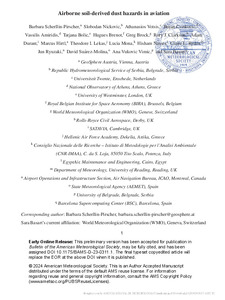Por favor, use este identificador para citar o enlazar este ítem:
http://hdl.handle.net/20.500.11765/16371
Airborne soil-derived dust hazards in aviation
| Título : | Airborne soil-derived dust hazards in aviation |
| Autor : | Scherllin-Pirscher, Barbara; Nickovic, Slodoban; Votsis, Athanasios; Cvetkovic, Bojan; Amiridis, Vassilis; Bolic, Tatjana; Brenot, Hugues; Brock, Greg; Clarkson, Rory J.; Durant, Adam; Hirtl, Marcus; Lekas, Theodore I.; Mona, Lucia; Nasser, Hisham; Ryder, Claire L.; Ryuzaki, Jun; Suárez Molina, David




|
| Palabras clave : | Dust hazards; Airborne; Mineral dust; Aviation safety |
| Fecha de publicación : | 2024 |
| Editor: | American Meteorological Society |
| Citación : | Bulletin of the American Meteorological Society. 2024 (Early Online Release) |
| Versión del editor: | https://doi.org/10.1175/BAMS-D-23-0311.1 |
| Resumen : | Airborne mineral dust poses a safety challenge for aviation. Several fatal accidents have happened in dust-laden air due to reduced visibility, strong gusty winds, and wind shear. Dust-induced icing also contributed at least to two fatal accidents. Furthermore, atmospheric dust has long- and short-term effects on aircraft operating condition due to corrosion and abrasion on the aircraft surfaces, and molten ingress deterioration of engine hot section components. The combined impact can increase operating and maintenance costs, and increase the overall cost of ownership. While the scientific community has started preparing and providing products based on atmospheric dust modeling and observation, there are still important data and information gaps in the fundamental science. These include (i) insufficient data which could be used to better understand the effects of dust on aircraft as well as on ground systems and operations (e.g., four-dimensional information of dust mineralogy, cost-benefit analysis of the impact of dust on aviation along flight routes), (ii) the identification of airborne dust monitoring and modeling products and services that could enable the flow of relevant information in commercial aviation and in decision-making workflows, and (iii) the underdeveloped, unclear, or absent role of dust hazards in regulations and operational procedures as well as in the training, skillset, and knowledge base of pilots. This review is aimed at both academic and aviation stakeholders, and presents the current state-of-the-art knowledge at the intersection of dust hazards, aviation safety, and impacts on flight operations and aircraft maintenance. |
| Patrocinador: | The authors also want to thank the DustClim project which is part of ERA4CS, an ERA-NET programme co-funded by the European Union’s Horizon 2020 research and innovation programme (grant no. 690462) and the AIRPLAN project funded by the Austrian Research Promotion Agency (FFG), research grant F0999900001. As part of KAIROS EU-Horizon project, this work has received funding from the SESAR Joint Undertaking (JU) under grant agreement N° 101114701. |
| URI : | http://hdl.handle.net/20.500.11765/16371 |
| ISSN : | 0003-0007 1520-0477 |
| Colecciones: | Artículos científicos 2023-2026 |
Ficheros en este ítem:
| Fichero | Descripción | Tamaño | Formato | ||
|---|---|---|---|---|---|
| BAMS_Suarez_2024.pdf | 2,65 MB | Adobe PDF |  Visualizar/Abrir |
Los ítems de Arcimis están protegidos por una Licencia Creative Commons, salvo que se indique lo contrario.





